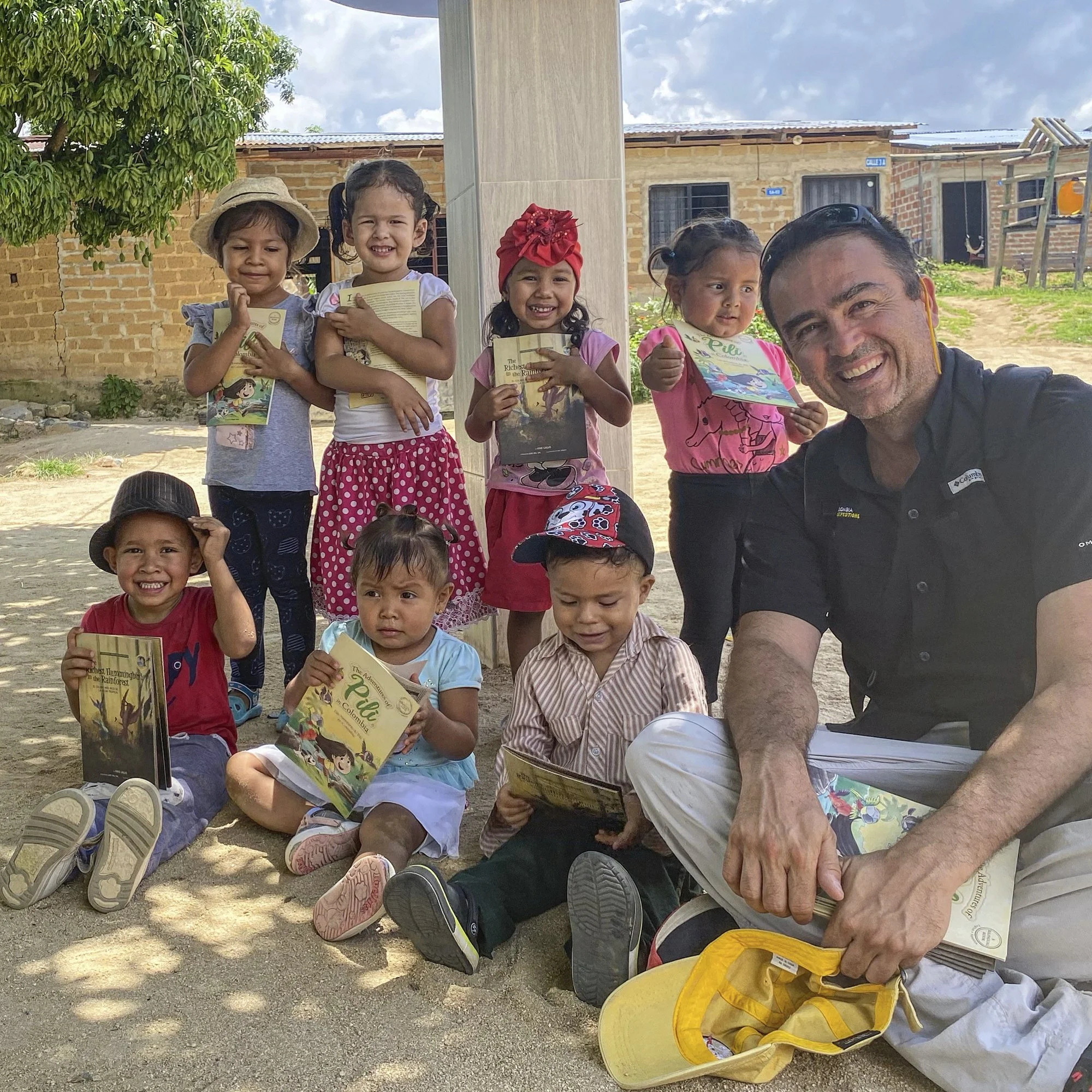From Words to Worlds: A Journey of Hope, Healing, and Resilience in Colombia
By Safina Center Fellow Kike Calvo
Christopher Calonje, from Colombia Photo Expeditions, reading books to the kids of former FARC members brim with excitement as they receive book donations ©Kike Calvo
We inhabit a world filled with contradictions. What if I were to share that I personally delivered dozens of my bilingual donated books to children of former Revolutionary Armed Forces of Colombia (FARC) members? The very same children are now being educated by the very person who once cared for someone in captivity during their time in the jungle. This individual had been kidnapped by the 41st Front of the FARC back in the early 2000s for 88 days.
Nineteen years later, I find myself witnessing radiant smiles on the faces of these children. In the humble setting of a kindergarten in the Cesar area, the radiance of my project illuminates the surroundings. As I reflect on Colombia's history, enveloped by the indescribable beauty of its mountains, thoughts of the future inevitably arise. This is the realm of dreamers – contemplating how my inspirational stories will cultivate future eco-warriors and how many trees will be planted as a direct result of my latest book, "The Girl Who Planted a Forest."
Seated with children of former FARC members, reading them my own stories, I couldn't help but marvel at the beauty of inspiring human creativity and love. ©Colombia Photo Expeditions
When you share stories with children, you're not simply embarking on exciting narratives – you're constructing their cognitive architecture. Picture neurons igniting like shimmering stars, illuminating their minds with language and imagination. These stories serve as a secret formula for enhancing brainpower, enriching vocabulary, and catalyzing young minds to think expansively. As you traverse pages filled with adventures, mysteries, and laughter, you're sowing seeds of empathy and emotional intelligence. And guess what?
We're not just confined to translating our books into languages like French, Japanese, or Chinese; we're also actively cultivating a library of bilingual children's literature in Indigenous languages such as Maya, Quechua, and Guna.
Sibundoy, a tranquil Colombian town cradled within the Andes, once bore witness to the tragic consequences of violence during the nation's prolonged armed conflict. The aftermath of displacement, disappearances, and the upheaval of traditional life left enduring scars within its close-knit community. As a multitude of armed groups and forces clashed, driven by strategic interests and drug trafficking routes, darkness descended. Yet, from this abyss emerged stories of resilience, a narrative deeply intertwined with indigenous heritage and a fervent pursuit of peace. Today, Sibundoy stands as a poignant symbol, embodying both the lingering wounds of violence and the remarkable resilience of the human spirit, pointing toward a future graced by peace, reconciliation, and renewal.
Picture, if you will, the sheer joy radiating from the children of Sibundoy upon receiving copies of "The Girl Who Planted the Forest" or "The Tale of a Flightless Mosquito," now available in Kamentsá, an indigenous language belonging to the Awa-Cuaiquer group, spoken within the local community.
Encountering two little girls laboring under seemingly heavy bags, likely filled with goods, raised curiosity. "Can I offer you something?" I called out. "No, thank you," they replied. "I don't seek anything in return; I only want to bring happiness and share a book." Their faces lit up with joy. ©Kike Calvo
In an imminent post, I will share the captivating chronicles of my journey across Colombia – a journey entailing the personal delivery of books to children in rural schools, along remote mountain trails, and within indigenous enclaves. This expedition led us to conquer even the notorious "Trampolín de la Muerte" or "Trampoline of Death," renowned as one of the world's most treacherous roads, connecting the Andes to the Amazon. Our adrenaline-infused escapades are encapsulated within an enthralling video, complete with multilingual subtitles, enabling you to be fully immersed in our odyssey. Stay tuned to witness firsthand the transformative influence of literature and exploration! Onward!
P.S. The term "Onward" was inspired by my exchanges with Wade Davis while he was crafting the foreword for my book "Corpus Christi in Atanquez." And if you feel adventurous, I invite you to join me to experience this unique indigenous celebration in 2024. Reach out to us for more details at Colombia Photo Expeditions.
Before the commencement of the Corpus Christi celebration, I journeyed to the village to distribute bilingual books to as many Kankuamo Indigenous children as possible. Their radiant faces tell the story. ©Colombia Photo Expeditions




